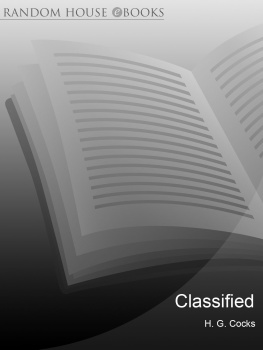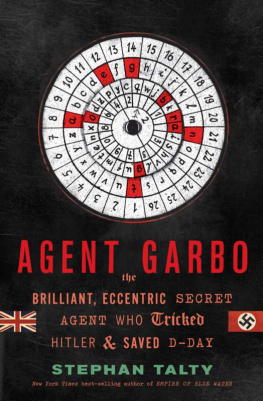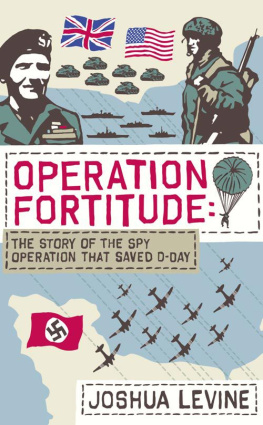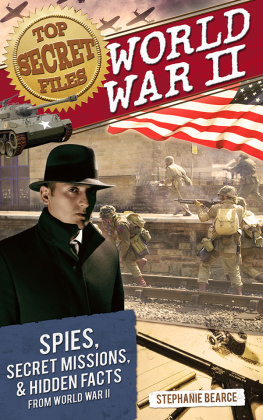GARBO: THE SPY WHO SAVED D-DAY
GARBO
THE SPY WHO SAVED
D-DAY
Introduction by Mark Seaman

Copyright: Crown Copyright 2000, 2004
Introduction Mark Seaman 2000, 2004
This edition of Garbo is published by arrangement with The National Archives, UK
All rights reserved. No part of this publication may be reproduced, stored in a retrieval system, or transmitted in any form or by any means, electronic, mechanical, photocopying, recording, or otherwise (except for brief passages for purposes of review) without the prior permission of Dundurn Press. Permission to photocopy should be requested from Access Copyright.
National Library of Canada Cataloguing in Publication Data
Harris, Toms, 1908
Garbo : the spy who saved D-Day / [Toms Harris] ; introduction by Mark Seaman.
Includes bibliographical references.
ISBN 1-55002-504-X
1. Pujol, Juan. 2. World War, 1939-1945 Secret service Great Britain--Sources. 3. Spies Great Britain Biography. I. Title.
D810.S8P843 2004 | 940.54'8641 | C2004-901927-9 |
1 2 3 4 5 08 07 06 05 04
Front cover:
contrasting photographs of Juan Pujol, codenamed GARBO, as he appeared in his wartime MI5 files (KV 2/70 and KV 2/71); Garbos message instructing the Germans that the D-Day troops were a diversionary manoeuvre (WO 208/4374)
Printed in the UK by Bath Press, Bath
www.dundurn.com
Dundurn Press
8 Market Street
Suite 200
Toronto, Ontario, Canada
M5E 1M6
Dundurn Press
2250 Military Road
Tonawanda NY
U.S.A. 14150
Contents
Mark Seaman
Toms Harris
Toms Harris
Publishers Note
This publication brings you in full the Summary of the Garbo Case 19411945 by Toms Harris. All document references are to the original files, which may be consulted under supervision at the National Archives, Kew. Our intention is to reproduce the material as faithfully as possible without compromising the integrity of the original. This means that the occasional inconsistency or typing error survives from Harriss text. The symbol [...] is used where material from the original document has been retained under section 3(4) of the Public Records Act 1958.
The introduction and index are modern additions.
Introduction
The Summary of the Garbo Case 19411945 is a remarkable document. It is the chronicle of the operational activities of Juan Pujol, codenamed GARBO, who has been described as the greatest double agent of the Second World War. However, this is no simple narrative by a detached historian or journalist, but rather the official report of Pujols MI5 case officer, Toms Harris, a man who directed, channelled, encouraged and sustained the agents remarkable talents. Together the two men, ably supported by various agencies of British intelligence, wove a web of deception that ensnared their German opposite numbers and misled the German High Command for years. Harriss summary offers a unique insight into the workings of British intelligence and the techniques of running an agent. Interestingly, it conflicts on several points with Pujols own memoirs that were written decades later when the agent emerged from obscurity. Neither account could claim to be impartial but Harriss clearly benefits from being based solidly upon the MI5 case files (many of which have not been released into the public domain) together with his own intimate knowledge of events. In his introduction Harris states an understandable pride in the success of the GARBO case:
In 1941 when the Germans were all powerful in Spain, the British Embassy in Madrid was being stoned, France had collapsed and the German invasion of England was imminent, little were the Germans to know that the small meek young Spaniard who then approached them and volunteered to go to London to engage in espionage on their behalf would turn out to be an important British agent. Still less were they to discover that the network which they instructed him to build up in the United Kingdom was to be composed of 27 characters who were nothing more than a figment of the imagination.
The summary of the story of this espionage network of imaginary characters, the GARBO NETWORK, the subject of this report is, if unorthodox, a record of the extent to which it is possible to deceive ones opponent, through what is probably the oldest weapon of deception in war, the double-cross agent.
Harriss report was written for internal distribution within MI5 and was not originally intended for a general public. It has all the pace of a thriller and contains a mass of intricate operational detail. However, readers must keep their wits about them if the miasma of falsehood, deception and deceit that surrounded the GARBO case is not to confuse them as profoundly as it did German intelligence. The story begins with Pujol in Madrid, moves with him to Lisbon, and is then centred in the United Kingdom. But the impact of his activities also embraces the campaigns in North Africa, the Normandy landings and the V-weapon offensive. Its pages are full of references to invasions, armies, fleets and bombing offensives, but it remains primarily the story of two men weaving one of the most incredible deception stratagems in history.
Historical background
The British intelligence community originated in 1909 with the formation of the Secret Service Bureau. It was a response to growing fears of Imperial Germany that warranted increased vigilance against spies in Britain and greater knowledge of the Kaisers military and political intentions. The Bureau consisted of two sections. The Home Section under Captain Vernon Kell was given the responsibility for countering hostile (and particularly German) espionage activity in Britain. It later acquired the titles MI5 and the Security Service, both of which it has retained. The Secret Service Bureaus Foreign Section, headed by Commander Mansfield Smith Cumming, was tasked with seeking information abroad on Britains potential foes. This later metamorphosed into MI6 or the Secret Intelligence Service (SIS).
Both organizations served their country well in the First World War. In the years before the outbreak of hostilities, Kells Section had managed to penetrate all of the German espionage rings in Great Britain. Some spies were arrested but the majority were kept under close observation until the declaration of war. Then the trap was quickly shut and 21 of the 22 still remaining at liberty were taken into custody.
It was reported during the war and confirmed after the Armistice that the capture of these spies completely broke up the German intelligence organisation which was not able to act effectively again until some time in 1915.
The effectiveness of the German espionage effort against Britain even after 1915 is open to question. The Germans did attempt to infiltrate a variety of agents, mostly of indifferent quality, but it proved extremely difficult to enter the United Kingdom, with strict travel regulations bolstered by a highly But the ruse could not be maintained indefinitely and the Germans eventually realized the deception that had been played upon them. The affair was hardly a great intelligence coup but nevertheless served as a precursor of later events.
Although their success in the First World War helped to ensure their continued existence after the end of hostilities, MI5 and SIS both suffered in the post-war reductions of staffing and funding. Moreover, the areas of specific responsibility were far from clear-cut and each pursued operations that led them into territory considered the domain of their sister service.
Next page











